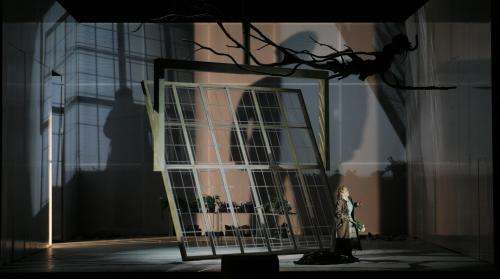|
Back
A Riveting Tightened Screw Los Angeles
Dorothy Chandler Pavilion
03/12/2011 - and 17, 20, 25, 27, 30 March 2011
Benjamin Britten: The Turn of the Screw
Patricia Racette (Governess), William Burden (Prologue/Peter Quint), Michael Kepler Meo (Miles), Ashley Emerson (Flora), Ann Murray (Mrs. Grose), Tamara Wilson (Miss Jessel)
Armen Anassian (Guest Concertmaster), Grant Gershon (Associate Conductor), James Conlon (Conductor)
Francesca Gilpin (Stage Director), Jonathan Kent (Original Production), Paul Brown (Scenery and Costume Designer), David Manion (Lighting Designer), Mark Henderson (Original Lighting Designer)

(© Robert Millard)
The question, “Do you believe in ghosts?”, has been around for years and continues to be a topic argued on both sides of the equation. Likewise, this age old chestnut factors into Benjamin Britten’s claustrophobic chamber opera, The Turn of the Screw, with poignant fashion. The nail-biting work, based on Henry James’ The Two Magics, journeys into the realm of supernatural ambiguity that is altogether unlike any other of the British composer’s creations.
Benjamin Britten’s piece is an extraordinary composition due its sheer layers of analytical precision. Similar to the highly mathematical patter quartet found in Verdi’s Falstaff, Britten injects ingenious calculations by using a haunting 12-note theme as the predominant base which connects eight scenes (variations) in each of the two symmetrical acts while abbreviating the orchestra to create greater intimacy, akin to James’ short story. Following Britten’s strict guidelines of limited strings, winds and percussion, conductor James Conlon elicits an atmosphere of musical coloring with dynamic brilliance.
Paul Brown’s minimal set centers around an enormous moving window pane that swivels on the x, y and z axes to lucidly delineate the sixteen different scenes including a churchyard, a living room, a schoolroom and a bedroom, to name a few. Because Britten’s variations are rather short, this requires Mr. Brown to intelligently economize and scale down to a handful of props. Francesca Gilpin’s stage direction alongside the visceral gifts of David Manion’s high impact lighting is significantly imposing and logistically appealing. Supplementing Brown’s sets are his creations of subdued and understated costuming representative of a wide range timeline from Victorian England to 1940s. This production hums along in comfortable cadence.

(© Robert Millard)
The Turn of the Screw contains only six actors, well executed by all cast members. Returning Patricia Racette is electrifying as the governess, a woman responsible for educating two orphaned children on the Bly estate while attempting to thwart encroachment of the youngsters’ supposed demonic apparitions, Peter Quint and Miss Jessel. The highly acclaimed soprano’s superb theatrics add to her already wide range of accomplishments. Although no easy task, she masters the character’s complexities with great agility.
William Burden makes his LA Opera debut as the Prologue’s narrator and Peter Quint. The voice carries with it a suave tonality and attenuated allure, especially during his beckoning to Miles. The roulades are engaging during The Bedroom and Piano Scenes and his use of punctuated staccato notes in the Quint Scene brings a chill down one’s spine.
One of Michael Kepler Meo’s trademark roles is that of the young Miles. He has previously sung the role at Portland Opera in 2009 and Houston Grand Opera in 2010. At the age of twelve there’s an understandable thinness in the vocal reach, but it is clearly compensated by his dynamic and sensible interpretation. No doubt, Mr. Meo has a promising career ahead of him.
Well on her way to operatic stardom is the young Ashley Emerson whose portrayal as Miles’ sister, Flora, is rendered with wonderful acting while her voice carries a distinctly pristine quality. Her conscientiousness as singer and actress weighs heavily and adds to the legitimacy of this production.
The Turn of the Screw would not be complete without the supporting roles of Mrs. Grose, interpreted with great pathos by first time LA Opera visitor Ann Murray while Tamara Wilson, filling the shoes as the macabre Miss Jessel, adds to an already powerful display of theatrical talent.
The first of three works leading up to the centennial of Benjamin Britten in 2013, The Turn of the Screw will be followed by the amusing 1947 opera, Albert Herring, in 2012, followed in 2013 by another opera yet to be announced. In the meantime, we can focus on this psychological thriller to give us enough drama to hold us tightly until the highly anticipated fête two years from now. You can make your decision whether or not you believe in ghosts after you’ve seen the trenchant The Turn of the Screw.
Christie Grimstad
|